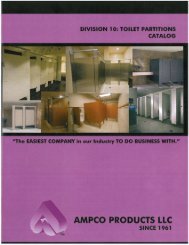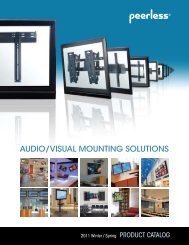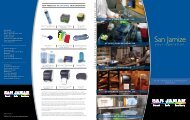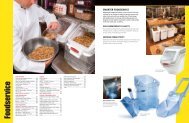view here - RTI Hotel Supply
view here - RTI Hotel Supply
view here - RTI Hotel Supply
Create successful ePaper yourself
Turn your PDF publications into a flip-book with our unique Google optimized e-Paper software.
MAINTENANCE INSTRUCTIONS<br />
bradleycorp.com<br />
STAINLESS STEEL<br />
Stainless Steel is a low-carbon steel that contains chromium. The addition of<br />
chromium gives the steel its unique corrosion-resisting properties. It is extremely<br />
durable, resists corrosion, and stands up to many chemicals.<br />
Despite the fact that stainless steel surfaces are generally non-tarnishing, they are<br />
not stain or rust proof. Stainless steel must be kept clean and free from contaminants.<br />
Frequent cleaning with mild soap and water or glass cleaner and a cotton cloth is required.<br />
Any discoloration or corrosion (commonly caused by contact with harsh cleaner, muriatic<br />
acid or bleach solutions) should be removed as soon as possible or permanent discolora tion<br />
and pitting of the surface could occur. Most discoloration can be removed with a mild<br />
cleanser or stainless steel cleaner and a Scotchbrite ® pad. The surface should then be<br />
thoroughly rinsed with clear water. With proper maintenance, stainless steel will maintain<br />
its luster and appearance indefinitely.<br />
MIRRORS<br />
Bradley mirrors are fabricated from heavy-gauge stainless steel frames and plate glass<br />
or an alternative reflective surface. The frame can be cared for by following the general<br />
stainless steel maintenance instructions above. Reflective surfaces can be cleaned with<br />
any standard non-abrasive glass cleaner and a soft cloth. Care must be taken to avoid<br />
allowing the cleaner to run down the surface of the mirror and collect in the frame.<br />
If allowed to continue, this could lead to premature silver spoilage and spotting on<br />
stainless steel.<br />
SOAP DISPENSERS<br />
Bradley soap dispensers provide dependable, consistent operation over the long term<br />
when the proper soap is used and when a minimal amount of periodic maintenance<br />
is performed on the valves. Soaps satisfying these basic guidelines will provide consistent<br />
flow and reduce clogs.<br />
Soap thickness is determined by a measurement called viscosity. Soap viscosity should be<br />
between 100 cps (centerpoise) and 2500 cps for all Bradley soap dispensers. The pH (acid)<br />
level of soaps that will perform consistently should be in the range of 6.5 to 8.5. More<br />
acidic soaps (pH levels lower than 6.5) will corrode metal parts (even stainless steel)<br />
and degrade rubber and plastic components. Most inexpensive soaps (typically the pink<br />
lotion type) fall into this acidic category and will eventually cause valve failure and metal<br />
corrosion. PCMX or Isopropanol-based antibacterial soaps (within viscosity and pH limits)<br />
will also work with Bradley dispensers.<br />
Valves must also be maintained (cleaned) to function properly. At the very minimum,<br />
hot water should be pumped through valves periodically to clear out soap residue.<br />
Ideally valves should occasionally be soaked for 30 minutes in hot water or a soap<br />
valve cleaning solution. With proper maintenance and soap, Bradley dispensers will<br />
provide long-term, trouble-free operation.<br />
BRADLEY ACCESSORIES 79

















